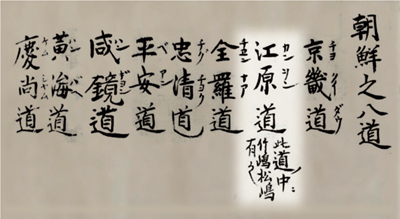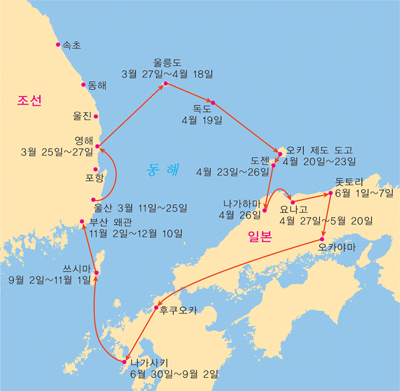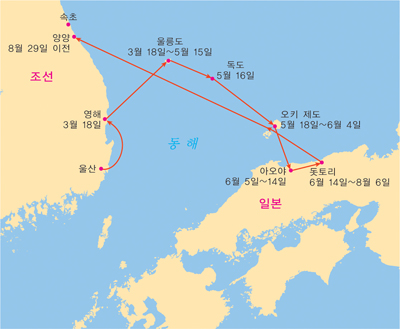- Dokdo in the East Sea
- Educational material
- High School Version
Dokdo in the East Sea
Table of Contents Open Contents
2. The An Yong-bok Incident and Japan’s Border Crossing Prohibition
-
- Objectives
-
Explain An Yong-bok’s efforts toward establishing Korea’s sovereignty over Dokdo.
Understand that both Ulleungdo and Dokdo were included in Japan’s Takeshima border crossing prohibition.
-
- Critical Thinking
-
An Yong-bok was a civilian who went to Japan on two separate occasions to proclaim Korea’s sovereignty over Dokdo. Why did he return to Japan in the face of danger?
Yong-bok An
An Yong-bok went to Japan on two separate occasions in 1693 and 1696 to advocate Korea’s sovereignty over Dokdo to the Japanese government.
Little is known about An Yong-bok’s personal life. A scholar in the late Joseon period, Yi Ik(1681-1763), described An Yong-bok in Digest of the Sacred Learning as a sailor from Dongnae (now Jwacheon, Busan) who served in the navy in Gyeongsang-do. At this time, he regularly visited the The Japan House and honed his skills in the Japanese language. Japanese records indicate that he was a private slave under a Seoul resident named Oh Chung-chu and that he lived in Busan.
He had multiple aliases including An Dong-ji, An Bi-jang, An Byeon-jang, and An Byeong-sa, among others. Japanese documents recorded his name as An Yong-bok. His age is unclear, as multiple records from 1696 indicate that he was 33, 36, and 43 at the time.
The An Yong-bok Incident
The diplomatic dispute that arose as a direct result of An Yong-bok’s multiple visits to Japan is collectively known as the An Yong-bok Incident. This incident is known as the Ulleungdo Border Dispute in Korean records and as the Takeshima Incident in Japan. To be more precise, the 1693 incident is known as the An Yong-bok Kidnapping Incident, and the 1696 incident is called An Yong-bok’s Visit to Japan.
A Full Account of the An Yong-bok Kidnapping Incident
In March 1693 (the nineteenth year of the reign of King Sukjong), An Yong-bok and 40 other fishermen from Ulsan conducted fishing activities near Ulleungdo. In April, he and Park Eo-dun were captured by Japanese fishermen and taken to the Oki Islands. When interrogated, An Yong-bok advocated Korean sovereignty over the Ulleungdo fishery to the Oki Island officials, and thus both men were sent to Yonago. He continued to claim Korea’s sovereignty over Ulleungdo and Dokdo in Yonago and protested his illegal capture.
The Yonago administrator who held the two men in detention sent an inquiry to the Edo shogunate through a Matsue domain lord in Edo (the old name for Tokyo). At this time, Matsue domain requested to the shogunate that Joseon fishermen be prohibited from entering Ulleungdo. The shogunate sent An and Park to Nagasaki, and after further investigation, ordered the release of these two men back to Joseon. However, the shogunate decided to send a Diplomatic Document to the Joseon government demanding that they prohibit Joseon fishermen from fishing near Ulleungdo (eleventh month of 1693).
This sparked a dispute between the two countries over which one had sovereignty over Ulleungdo and Dokdo (1694-1695). During this time, the Edo Shogunate sent an inquiry to the Tottori clan in regards to Ulleungdo and Dokdo’s domain.
After much research and a dispute that lasted over two years, the Edo shogunate acknowledged Ulleungdo and Dokdo to be Joseon territory. The shogunate issued the Takeshima (Ulleungdo) border crossing prohibition, which forbade Japanese fishermen from trespassing on Ulleungdo (first month of 1696).
An Yong-bok and Park Eo-dun arrived at Tsushima in the sixth month of 1693, and both men were repatriated to the Japan House in Busan in the ninth month. An Yong-bok was detained in Tsushima for about 50 days, and even after arriving in Busan, he was detained for another 40 days until his release in the twelfth month of 1693.
-
Note: When Matsudaira Shintarō was lord of Matsue domain, he inquired to the councilor about two merchants from Yonago in Matsue domain, Murakawa Ichibei and Oya Jinkichi, who had previously crossed the border to Takeshima for fishing. The shogunate instructed that they be prohibited from further border crossings to Takeshima (Ulleungdo).
An Yong-bok’s Second Visit to Japan
After being imprisoned for two years for illegal trespassing, An Yong-bok returned to Japan to advocate Joseon’s sovereignty over Ulleungdo and to prohibit Japanese fishermen from entering Ulleungdo’s area.
An Yong-bok went to Ulleungdo in 1696 (the twenty-second year of the reign of King Sukjong) along with four Ulsan fishermen, one nobleman, and five monks. An confronted Japanese fishermen over trespassing in Ulleungdo. As the Japanese fishermen retreated to Jasando (Dokdo) and then to the Oki Islands, An followed them to Japan. He once again advocated Joseon’s sovereignty over Ulleungdo and Jasando and requested to report the incident to the daimyo of Matsue domain (han). With no response from the daimyo, An decided to enter Matsue domainand protest directly. Under false pretenses, he donned an official uniform and went to Matsue domain with a flag that read “Ulleung Jasan Tax Administrator .” He presented the “Map of the Eight Provinces” as evidence of Joseon’s sovereignty over Dokdo.
An Yong-bok’s protest was immediately reported to the shogunate through the Matsue domain government. Eventually, An and his companions were deported. They returned to Yangyang, Gangwon-do, in the eighth month of 1696.
An Yong-bok and his companions were investigated by the Border Defense Council for illegal trespassing and sentenced to death for their crimes. However, several officials acknowledged An Yong-bok’s contributions for claiming Joseon sovereignty over Ulleungdo and Dokdo and revealing the events in the area. In recognition, he was sentenced to be exiled rather than executed in the third month of 1697.
-
- Figure
-
Tsushima domain, the diplomatic bridge between Joseon and Japan
Diplomatic correspondence between Joseon and Japan was conducted through Tsushima domain. When Japan’s Edo shogunate sent a representative to the Japan House in Busan through Tsushima domain, the Joseon government would send an administrative official to Dongnae to discuss foreign affairs.
Records Recently Discovered In Japan

Genroku 9 Year of the Rat Korean Coastal Nautical Scrolls”: An Yong-bok’s interrogation recordsAt the time, Japan referred to Ulleungdo and Dokdo as Takeshima and Matsushima, respectively. Songdo (Matsushima) on the map indicates Dokdo.

-
- Activity 1
-
Identify the names of the two islands recorded in the “Eight Provinces of Joseon” section of the “Genroku 9 Year of the Rat Korean Coastal Nautical Scrolls.”
-
- Activity 2
-
Discuss the Joseon government’s position on An Yong-bok’s activities and punishment.
Japan Issues the Takeshima border crossing prohibition in 1696
The Ulleungdo/Dokdo territorial disputes that began in 1693 ultimately resulted in the Edo shogunate resolving the issue with the Takeshima border crossing prohibition. The Edo shogunate made an inquiry to the daimyo of Matsue domain regarding whether the two islands were under Matsue domain jurisdiction (twelfth month of 1695), to which the Matsue domain daimyo replied, “From Joseon to Matsushima (Dokdo) is 80-90 ri, Matsushima (Dokdo) to Takeshima (Ulleungdo) is 40 ri, and Oki Island to Matsushima (Dokdo) is 80 ri. Ulleungdo and Dokdo are not part of Matsue domain’s jurisdiction.” (first month of 1696) 1. .
The shogunate issued the Takeshima border crossing prohibition on the twenty-eighth day of the first month of 1696 to Matsue domain. Japan had acknowledged Joseon’s sovereignty over Dokdo. However, the Takeshima border crossing prohibition was not immediately received by Matsue domain, and was received much later by the Joseon government, in the tenth month of that year.
-
- Activity 3
-
The distances between the two islands to Joseon and Japan, as surveyed by the Matsue domain. Convert the nautical ri (mile) to kilometers. (1 nautical ri = 1,852 meters, 1 ri = 0.4 kilometers)
• Matsushima (Dokdo) to Takeshima (Ulleungdo) is 40 ri → 40 nautical ri → 74.6 kilometers → approx. 190 ri
• Joseon to Matsushima (Dokdo) is 80-90 ri → ( ) nautical ri → ( ) kilometers → approx. ( ) ri
• Oki Islands to Matsushima (Dokdo) is 80 ri → ( ) nautical ri → ( ) kilometers → approx. ( ) ri
-
- Figure
-
Dokdo is included in the Takeshima (Ulleungdo) border crossing prohibition.
Some Japanese scholars have stated that the Takeshima border crossing prohibition only applies to Ulleungdo and does not include Dokdo. However, there was never an instance in which Japanese fishermen overlooked Ulleungdo and only focused on Dokdo. Therefore, it is reasonable to believe that the Takeshima border crossing prohibition included Matsushima (Dokdo) as well, and a separate Dokdo border crossing prohibition by the Edo shogunate would have been unnecessary.
Ulleungdo and Dokdo after the An Yong-bok Incident
After An Yong-bok returned to Joseon in the fourth month of 1693, the Joseon government dispatched Jang Han-sang to investigate Ulleungdo and its neighboring islands. Jang reported the following in Ulleungdo Study.
-
After climbing to the summit on a clear day, two towering peaks were visible in the southern and northern areas. This is the so-called Three Peaks. A great mountain ridge is visible to the west, and a small island is barely visible in the southwestern seas. The island’s size is only one-third that of Ulleungdo and it is located approximately 300 ri away.
Reference Documents on the Eastern Country (1770) contained in it. The State Geographical Survey, in which was written, “Ulleung and Usan are part of Usan, and Usan is referred to as Songdo by foreigners.” This information solidifies the fact that Usando = Matsushima = Dokdo. This information is also included in Essentials of Governance (1808) and Comprehensive Study of Civilization, Revised and Expanded (1908).
Joseon’s Correspondence after the An Yong-bok Incident

Ulleungdo stone engravingsEngraved by the administrator Lee Gyu-won while exploring and surveying Ulleungdo in 1882.

To prove that the duties were performed, the search official would bring back juniper, red clay, sea lion leather, and other specialties from Ulleungdo for the king. The official would even carve his name on the rocks of Ulleungdo. Excluding times of famine, this process was carried out continuously. As a result, a wealth of information and knowledge about Ulleungdo and its neighboring islands was amassed, which is reflected in the historical documents and maps.
-
- Activity 4
-
Examine An Yong-bok’s activities and their significance.
-
- Activity 5
-
Korean historical sources with references to Dokdo are listed chronologically. Fill in the blanks with the correct information.
-
Year Title (Author) Contents 512 History of the Three Kingdoms, Silla Section, King Jijeung In the sixth month of the thirteenth year of the reign of King Jijeung (512), Usan surrendered and paid annual tribute thereafter. Usan was located directly east of Myeongju and is also referred to as Ulleungdo. 1451 History of Goryeo Geographical Records Usan and Mureung are close enough that the other is visible on a clear day. 1454 The Annals of King Sejong Geographical Records The two islands are close enough that the other is visible on a clear day. The island was called ( ) in the Silla period. 1531 New and Expanded Complete Conspectus of the Territory of the Eastern Country The two islands are located in the middle of the East Sea. (Omitted) On a clear day, the sandbar and the trees on the mountain peak can be vividly seen .… After 1696 “Ulleungdo” (Park Se-dang) ( )’s topography is low, so unless the weather is clear or looking from the highest point, [the island] is not visible. 1756 Notes on Joseon’s Frontiers (Sin Gyeong-ju) A study of multiple maps indicate that they are two separate islands. One of the islands is what the foreigners call Songdo. Both islands are part of the ( ). 1770 Reference Documents on the Eastern Country State Geographical Survey stated, “Ulleung and Usan are part of the State of Usan, and Usan is referred to as Songdo by foreigners.” 1808 Essentials of Governance ( ) stated, “Ulleung and Usan are part of the State of Usan, and Usan is referred to as Songdo by foreigners.” 1908 Comprehensive Study of Civilization, Revised and Expanded State Geographical Survey stated, “Ulleung and Usan are part of Usan, and Usan is referred to as Songdo by foreigners.”
Yi Ik
Pen name Seongho. As a Silhak philosopher and Neo-Confucian scholar, Yi Ik fought for the freedom of slaves and argued that even nobility must actively participate in his livelihood. Digest of the Sacred Learning is his most famous work.
닫기
The Japan House
The Japan House was a place for diplomatic relations and trade between Korea and Japan in the Joseon period. The Japan House in Dongnae, in Busan is well-known.
닫기
Park Eo-dun
Park Eo-dun, a fisherman from Ulsan, was captured and taken to Japan in the third month of 1693. He was repatriated to the Japan House in Busan in the eleventh month of that year.
닫기
Yonago
A large city in Matsue domain at the time of the incident, it is now part of Tottori Prefecture.
닫기
Diplomatic Document
An official document of communication sent between Joseon and Japan. This document was used for diplomatic communications and as a visa.
닫기
councilor
senior official in the Edo government
닫기
Ulleung Jasan Tax Administrator
Although he claimed to be a tax administrator for Ulleungdo and Jasando (Dokdo), this was not an actual position in the Joseon government.
닫기
Genroku 9 Year of the Rat Korean Coastal Nautical Scrolls
This document was recorded by An Yong-bok’s interrogator during An’s second visit to Japan in 1696
닫기
Border Defense Council
A governing body established in the early sixteenthcentury for military administration. It was strengthened after repeated foreign invasions.
닫기
ri
The Japanese ri was equivalent to 10 ri in Joseon. This usage of ri here is as a nautical ri (mile). A nautical ri (mile) is 1,852 miles, and 40 nautical ri (miles) is approximately 190 ri. The distance between Ulleungdo and Dokdo is about 220 ri (87.4 kilometers).
닫기
Reference Documents on the Eastern Country
Compiled in accordance with the king’s order in 1770, this encyclopedia includes civil and institutional information that spans 100 volumes covering 13 different topics. In 1908, the compilation was further revised and published as the Comprehensive Study of Civilization, Revised and Expanded, which contained 250 volumes covering 16 different topics.
닫기
Essentials of Governance
This text was composed from financial and military information in 1808 as a reference for the king.
닫기
















